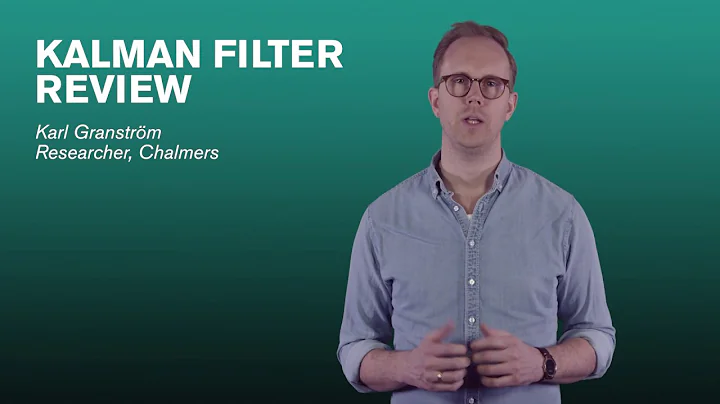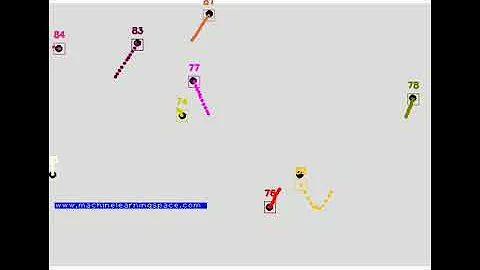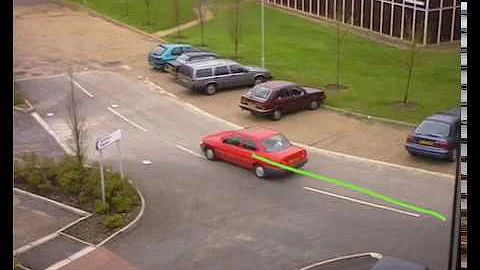Multiple Object Tracking with Kalman Filter
If you are tracking multiple unrelated objects you can just replicate your constant-velocity Kalman filter for every target you are tracking. This would be the most efficient way to do it.
If you thought your targets were related in some way (e.g. that error in measuring them had a common component, or if the behavior of one would influence your prediction of the behavior of another) then you could combine them all together. You would take your existing 4x4 matrix (x, y, vx, vy) and combine them in a block-diagonal fashion to make a larger matrix. The larger covariance matrix would now have regions that indicate how uncertainty of one measurement is related to another. Let's say you think your camera may be shaking. You would then expect all objects might have the same angular noise. You could include that idea in your R matrix with off-diagonal terms tying all the measurements together. This form will be much more costly computationally (because of the nonlinear cost of matrix math) and would also add complexity when adding or removing targets.
Related videos on Youtube
Shan
Updated on June 04, 2022Comments
-
Shan almost 2 years
I am new on OpenCV. I am always wish to learn new image processing technologies / Programming. I have seen few tutorial on Object detection, tracking, counting etc. I wish to learn the same and try to make my own similar project.
With lot of searching on internet and papers. Finally i came to know about Kalman Filter for object tracking. I have used following codes as per following:
- Background Subtract
- Smoothing , Blur etc. filters.
- Find Contours
- Draw Rectangle and find Centroid.
- Apply Kalman Filter
Now, i can track ONE Object with my codes. I want to track multiple objects.(i.e. people running on the roads, vehicle running etc.)
I would be pleased and appreciate if someone can guide me or give me example codes to try with.
Looking forward your positive reply. Shan
using namespace std; using namespace cv; #define drawCross( img, center, color, d )\ line(img, Point(center.x - d, center.y - d), Point(center.x + d, center.y + d), color, 2, CV_AA, 0);\ line(img, Point(center.x + d, center.y - d), Point(center.x - d, center.y + d), color, 2, CV_AA, 0 )\ vector<Point> mousev,kalmanv; cv::KalmanFilter KF; cv::Mat_<float> measurement(2,1); Mat_<float> state(4, 1); // (x, y, Vx, Vy) int incr=0; void initKalman(float x, float y) { // Instantate Kalman Filter with // 4 dynamic parameters and 2 measurement parameters, // where my measurement is: 2D location of object, // and dynamic is: 2D location and 2D velocity. KF.init(4, 2, 0); measurement = Mat_<float>::zeros(2,1); measurement.at<float>(0, 0) = x; measurement.at<float>(0, 0) = y; KF.statePre.setTo(0); KF.statePre.at<float>(0, 0) = x; KF.statePre.at<float>(1, 0) = y; KF.statePost.setTo(0); KF.statePost.at<float>(0, 0) = x; KF.statePost.at<float>(1, 0) = y; setIdentity(KF.transitionMatrix); setIdentity(KF.measurementMatrix); setIdentity(KF.processNoiseCov, Scalar::all(.005)); //adjust this for faster convergence - but higher noise setIdentity(KF.measurementNoiseCov, Scalar::all(1e-1)); setIdentity(KF.errorCovPost, Scalar::all(.1)); } Point kalmanPredict() { Mat prediction = KF.predict(); Point predictPt(prediction.at<float>(0),prediction.at<float>(1)); KF.statePre.copyTo(KF.statePost); KF.errorCovPre.copyTo(KF.errorCovPost); return predictPt; } Point kalmanCorrect(float x, float y) { measurement(0) = x; measurement(1) = y; Mat estimated = KF.correct(measurement); Point statePt(estimated.at<float>(0),estimated.at<float>(1)); return statePt; } int main() { Mat frame, thresh_frame; vector<Mat> channels; VideoCapture capture; vector<Vec4i> hierarchy; vector<vector<Point> > contours; // cv::Mat frame; cv::Mat back; cv::Mat fore; cv::BackgroundSubtractorMOG2 bg; bg.nmixtures = 3; bg.bShadowDetection = false; int incr=0; int track=0; capture.open("E:/demo1.avi"); if(!capture.isOpened()) cerr << "Problem opening video source" << endl; mousev.clear(); kalmanv.clear(); initKalman(0, 0); while((char)waitKey(1) != 'q' && capture.grab()) { Point s, p; capture.retrieve(frame); bg.operator ()(frame,fore); bg.getBackgroundImage(back); erode(fore,fore,Mat()); erode(fore,fore,Mat()); dilate(fore,fore,Mat()); dilate(fore,fore,Mat()); dilate(fore,fore,Mat()); dilate(fore,fore,Mat()); dilate(fore,fore,Mat()); dilate(fore,fore,Mat()); dilate(fore,fore,Mat()); cv::normalize(fore, fore, 0, 1., cv::NORM_MINMAX); cv::threshold(fore, fore, .5, 1., CV_THRESH_BINARY); split(frame, channels); add(channels[0], channels[1], channels[1]); subtract(channels[2], channels[1], channels[2]); threshold(channels[2], thresh_frame, 50, 255, CV_THRESH_BINARY); medianBlur(thresh_frame, thresh_frame, 5); // imshow("Red", channels[1]); findContours(fore, contours, hierarchy, CV_RETR_EXTERNAL, CV_CHAIN_APPROX_SIMPLE, Point(0, 0)); vector<vector<Point> > contours_poly( contours.size() ); vector<Rect> boundRect( contours.size() ); Mat drawing = Mat::zeros(thresh_frame.size(), CV_8UC1); for(size_t i = 0; i < contours.size(); i++) { // cout << contourArea(contours[i]) << endl; if(contourArea(contours[i]) > 500) drawContours(drawing, contours, i, Scalar::all(255), CV_FILLED, 8, vector<Vec4i>(), 0, Point()); } thresh_frame = drawing; findContours(fore, contours, hierarchy, CV_RETR_EXTERNAL, CV_CHAIN_APPROX_SIMPLE, Point(0, 0)); drawing = Mat::zeros(thresh_frame.size(), CV_8UC1); for(size_t i = 0; i < contours.size(); i++) { // cout << contourArea(contours[i]) << endl; if(contourArea(contours[i]) > 3000) drawContours(drawing, contours, i, Scalar::all(255), CV_FILLED, 8, vector<Vec4i>(), 0, Point()); } thresh_frame = drawing; // Get the moments vector<Moments> mu(contours.size() ); for( size_t i = 0; i < contours.size(); i++ ) { mu[i] = moments( contours[i], false ); } // Get the mass centers: vector<Point2f> mc( contours.size() ); for( size_t i = 0; i < contours.size(); i++ ) { mc[i] = Point2f( mu[i].m10/mu[i].m00 , mu[i].m01/mu[i].m00 ); /* for(size_t i = 0; i < mc.size(); i++) { // drawCross(frame, mc[i], Scalar(255, 0, 0), 5); //measurement(0) = mc[i].x; //measurement(1) = mc[i].y; // line(frame, p, s, Scalar(255,255,0), 1); // if (measurement(1) <= 130 && measurement(1) >= 120) { // incr++; // cout << "Conter " << incr << " Loation " << measurement(1) << endl; // } }*/ } for( size_t i = 0; i < contours.size(); i++ ) { approxPolyDP( Mat(contours[i]), contours_poly[i], 3, true ); boundRect[i] = boundingRect( Mat(contours_poly[i]) ); } p = kalmanPredict(); // cout << "kalman prediction: " << p.x << " " << p.y << endl; mousev.push_back(p); for( size_t i = 0; i < contours.size(); i++ ) { if(contourArea(contours[i]) > 1000){ rectangle( frame, boundRect[i].tl(), boundRect[i].br(), Scalar(0, 255, 0), 2, 8, 0 ); Point center = Point(boundRect[i].x + (boundRect[i].width /2), boundRect[i].y + (boundRect[i].height/2)); cv::circle(frame,center, 8, Scalar(0, 0, 255), -1, 1,0); s = kalmanCorrect(center.x, center.y); drawCross(frame, s, Scalar(255, 255, 255), 5); if (s.y <= 130 && p.y > 130 && s.x > 15) { incr++; cout << "Counter " << incr << endl; } for (int i = mousev.size()-20; i < mousev.size()-1; i++) { line(frame, mousev[i], mousev[i+1], Scalar(0,255,0), 1); } } } imshow("Video", frame); imshow("Red", channels[2]); imshow("Binary", thresh_frame); } return 0; }




